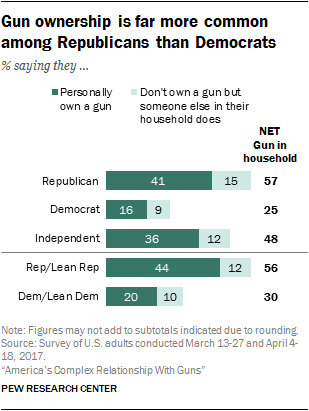Cognitive Dissonance
Guns Versus American Exceptionalism
Cognitive dissonance in the crosshairs.
Posted February 25, 2018

An important contradiction within America’s gun debate has been overlooked: Is America uniquely great or uniquely flawed? Many people who argue for strict gun control regulations cite the high number and easy availability of guns as the key reasons for the high rates of gun homicides and mass shootings compared with other developed countries. This position may be summed up as: Too many guns is the primary reason for so much gun violence. Many who oppose strict gun regulation or bans disagree, of course. The problem is bad people and not the guns, they say. Therefore, by this logic, fewer guns in America won’t matter. This is the essence of the popular claim: Guns don’t kill people, people kill people.
Conservatives are far more likely to own guns and support looser gun laws. The Pew Research Center reported in 2017 that 57 percent of Republican households contain at least one gun whereas 25 percent of Democrat households do. Conservatives/Republicans also tend to say they are more committed to American patriotism than others. According to a 2016 Gallup poll, significantly higher numbers of conservatives declare themselves to be “extremely proud to be American” than liberals do (61 percent versus 36 percent). Many if not most of those who strongly support gun ownership are vocal patriots and believe strongly in the concept of American exceptionalism, the claim that the United States is unique and superior to all other nations. There is a glaring contradiction here that has gone unrecognized.

The NRA and many gun advocates claim that it is not the number and availability of guns in America that is the central problem but rather it’s bad or deranged people who commit crimes with guns. This position is problematic for them, however, because it conflicts with American exceptionalism. If they let guns off the hook, then they are effectively implying that US society is inferior in some fundamental way compared with all the other democratic and wealthy nations that do not suffer so many mass shootings.
For those who have not been paying attention, the differences between the US and other developed and wealthy countries are striking. In the United States 64 percent of all homicides are gun related. In England and Wales it’s 4.5 percent. In Australia the figure is 13 percent. The US alone accounts for more than 30 percent of all mass shootings globally. No other country in the world has mass shootings at a comparable rate. Finally, the gun homicide rate in the United States is more than 25 times higher than any other wealthy/developed nation on Earth. (World Health Organization).
The United States is first among developed nations in gun ownership and first in mass shootings. These two things are connected, according to credible scientific research. For example, an important cross-national study of 171 countries, published in 2016, found that high gun ownership correlates with a country’s susceptibility to public mass shootings—even if it is relatively peaceful and its people do not suffer extraordinarily high rates of mental illness (Adam Lankford, “Public Mass Shooters and Firearms: A Cross-National Study of 171 Countries,” Violence Vict. 2016;31(2):187-99.)

The United States is saturated with guns. Americans make up less than 5 percent of the world’s population yet own nearly half (48 percent) of all civilian-owned guns on the planet. (US Congressional Research Service). A Pew study found that 66 percent of US gun owners own multiple firearms. There are now enough firearms in circulation for every American man, woman, and child to have two if evenly distributed. If this is not the key reason for the death-by-gun problem, then American exceptionalism—as it is described and promoted by many gun advocates—must mean something other than great and superior.
To help make the point, imagine flooding another country—say France, South Korea, or Japan— with enough guns to match America’s two-guns-per-citizen ratio. Can anyone honestly argue that the rate of gun homicides and mass shootings would not rise as a result? Availability is America’s primary challenge with guns and it is time for gun advocates to admit this. Unless, of course, they are ready to argue that the people of the United States are somehow uniquely savage and criminally insane—which is not supported by research. They can’t have it both ways.
There are always multiple factors to consider with every violent gun incident. But the basic equation should be clear to all who care to think. It is a conclusion no one who has reviewed the data can honestly refute.
More guns equal more death.
Additional reading
The Harvard Injury Control Research Center reviewed key studies on gun violence in the United States and internationally. Here are some highlights:
Where there are more guns there is more homicide
“Our review of the academic literature found that a broad array of evidence indicates that gun availability is a risk factor for homicide, both in the United States and across high-income countries. Case-control studies, ecological time-series and cross-sectional studies indicate that in homes, cities, states and regions in the U.S., where there are more guns, both men and women are at a higher risk for homicide, particularly firearm homicide.”
Hepburn, Lisa; Hemenway, David. Firearm availability and homicide: A review of the literature. Aggression and Violent Behavior: A Review Journal. 2004; 9:417-40.
Across high-income nations, more guns = more homicide
“We analyzed the relationship between homicide and gun availability using data from 26 developed countries from the early 1990s. We found that across developed countries, where guns are more available, there are more homicides. These results often hold even when the United States is excluded.”
Hemenway, David; Miller, Matthew. Firearm availability and homicide rates across 26 high income countries. Journal of Trauma. 2000; 49:985-88.
Across states, more guns = more homicide
“Using a validated proxy for firearm ownership, we analyzed the relationship between firearm availability and homicide across 50 states over a ten-year period (1988-1997). After controlling for poverty and urbanization, for every age group, people in states with many guns have elevated rates of homicide, particularly firearm homicide.”
Miller, Matthew; Azrael, Deborah; Hemenway, David. Household firearm ownership levels and homicide rates across U.S. regions and states, 1988-1997. American Journal of Public Health. 2002; 92:1988-1993.
Across states, more guns = more homicide (2)
“Using survey data on rates of household gun ownership, we examined the association between gun availability and homicide across states, 2001-2003. We found that states with higher levels of household gun ownership had higher rates of firearm homicide and overall homicide. This relationship held for both genders and all age groups, after accounting for rates of aggravated assault, robbery, unemployment, urbanization, alcohol consumption, and resource deprivation (e.g., poverty). There was no association between gun prevalence and non-firearm homicide.”
Miller, Matthew; Azrael, Deborah; Hemenway, David. State-level homicide victimization rates in the U.S. in relation to survey measures of household firearm ownership, 2001-2003. Social Science and Medicine. 2007; 64:656-64.
A summary of the evidence on guns and violent death
“This book chapter summarizes the scientific literature on the relationship between gun prevalence (levels of household gun ownership) and suicide, homicide and unintentional firearm death and concludes that where there are higher levels of gun ownership, there are more gun suicides and more total suicides, more gun homicides and more total homicides, and more accidental gun deaths. ... This is the first chapter in the book and provides and up-to-date and readable summary of the literature on the relationship between guns and death. It also adds to the literature by using the National Violent Death Reporting System data to show where (home or away) the shootings occurred. Suicides for all age groups and homicides for children and aging adults most often occurred in their own home.”
Miller M, Azrael D, Hemenway D. Firearms and violence death in the United States. In: Webster DW, Vernick JS, eds. Reducing Gun Violence in America. Baltimore MD: Johns Hopkins University Press, 2013.
More guns = more homicides of police
“This article examines homicide rates of Law Enforcement Officers (LEOs) from 1996 to 2010. Differences in rates of homicides of LEOs across states are best explained not by differences in crime, but by differences in household gun ownership. In high gun states, LEOs are 3 times more likely to be murdered than LEOs working in low-gun states.”
Swedler DI, Simmons MM, Dominici F, Hemenway D. Firearm prevalence and homicides of law enforcement officers in the United States. American Journal of Public Health. 2015; 105:2042-48.




